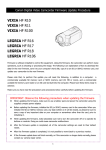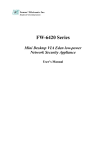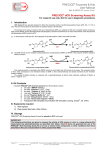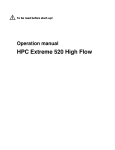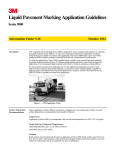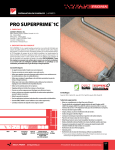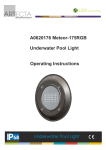Download Operating Instructions ATEC – Operating gears
Transcript
Operating Instructions ATEC – Operating gears ______________________________________________________________________________________________________________ 1 2 3 4 5 6 7 8 9 10 General Safety Aspects Product Description and Range of Application Design of operating gears Transport Storage Installation Commissioning Operation and Application Maintenance ______________________________________________________________________________________________________________ 1 General The technical data of the order are binding for the type of design. Modifications can only be considered if they are specified to us in time before starting production. Every ATEC Operating gear is checked for completeness and performance before leaving the factory. In case of non-compliance with these Operating Instructions, we cannot be made liable for any damages or troubles resulting thereof. We reserve the right to technical modifications as against the data and representations contained in these Operating Instructions in case this should be necessary for improving the Operating gears. 2 Safety Aspects The ATEC Operating gears are reliable and designed to the state of the art. However, risks could be involved if the product is handled in an inexpert manner by untrained staff and not used in accordance with its duty and purpose. Whoever is engaged in mounting, operation and maintenance, inspection and repair of the ATEC Operating gears, is supposed to have read the complete Operating Instructions and to have understood them (VBG1 § 14 and following). The user is recommended to have the person involved confirm this fact in writing in each particular case (VGB1 § 7 Abs. 2). Before removing safety devices and/or carrying out work on the ATEC Operating gears, the section, the pit or reservoir must be drained and dried eliminating any risk. Unauthorized, erroneous, and unexpected operation as well as dangerous movements by accumulated energy (compressed air, compressed water, weights, hydraulic energy) have to be excluded. When using ATEC Operating gears the approved technical regulations have to be observed (DIN, DVGW, VDI, VDMA, etc.). For installations to be supervised the relevant rules and regulations have to be observed (GO, VBG, TRD, SR, TRG,TRbF, TRGL, TRAC, AD, etc.). Furthermore, the local safety regulations and rules for prevention of accidents are applicable. If work is carried out in the vicinity of the ATEC Operating gears, which leads to soiling (concrete work, masonry, painting, shotblasting, welding, and grinding work, etc.) it must be covered. 3 Product Description and Range of Application Operating drives are universally applicable drive components which are designed according to the valves size, performance and kind of activity. We recommend at hand-operated penstocks from DN 700 or BxH 700 x 700 the use of rolling bearing and from DN 1200 or BxH 1200x1200 the application of bevel gearbox. 4 Design of operating gears Drive units: • Support Bracket • Protruding Headstock • Central Headstock • Thrust Bridge • Ceiling-mounted Operating Gear • Wall Bracket • Protruding Top Bracket • Top Bracket Linkage / Extension rod: • Handle • Square cap – alone / with spur gearbox • Handwheel or Crank handle – alone / with bevel gearbox • Cylinder (hydraulic/pneumatic) • Electric actuator ATEC GmbH • Brenzstraße 24 • D-89518 Heidenheim Telefon 07321 / 277777 • Fax 07321 / 277778 www.atec-hdh.de • • 5 Manual lifting rod Extension rod Transport Transport has to be carried out carefully. Inexpert handling may cause damages. Such damages have to be reported immediately to ATEC. Prior to mounting, such damages have to be repaired in an appropriate manner. If the ATEC Operating gear is too heavy to be handled manually it has to be transported by means of lifting gears which have to be attached at suitable places. It is not allowed to attach the lifting gears to the handwheel, the stem, the gearbox casing or other sensitive components which would be contrary to the relevant safety regulations. 6 Storage During the storage period, the ATEC Operating gear has to be protected against outside influences and impurities (e.g. by covering them with a tarpaulin). The ATEC Operating gear has to be stored flat on the frame with intermediate boards. If long-time storage is required, the place of storage should be selected in such a way that the following conditions are met: frostprotected - cool - dry - dust-free. If it is impossible to comply with these conditions, the ATEC Operating gear must be packed to meet these requirements, e.g. it has to be welded in foil. For operating gears, the safety regulations of the corresponding manufacturer are applicable. 7 Installation 7.1 Principles According to their design, the ATEC Operating gears are anchor-bolted, grouted, screwed on or anchored into the structure by a combination of these two procedures. On principle, installation should be performed by the ATEC expert staff. In case installation is performed by a third party, an ATEC specialist can give the corresponding installation instructions and supervise the installation. If the mounting work is done by a third party, the client or the mounting company is responsible for proper installation, testing, and commissioning. For installation, the ATEC Operating gear has to be in perfect condition. All defects have to be reported immediately to ATEC and to be repaired before installation according to mutual agreement. 7.2 Requirements to the Structure The structure has to be complete, i.e. the corresponding constructional section has to be complete with all surfaces and recesses necessary for installation of the ATEC Operating gear being geometrically available and plane-parallel and even. The design of the interface between structure and ATEC Operating gear has to be carried out according to the relevant standards for structures (DIN 18202, DIN 19556, DIN 19569, etc.). 7.3 General Notes Remove all packing material. Prior to installation, check the mounting area for impurities and foreign bodies and clean it if necessary. It is important that all around the ATEC Operating gear there is free access for operation and maintenance. During the mounting process, corrosion protection and coatings must not be damaged. Particular attention has to be paid during welding or grinding works. If the surface is damaged, these defects have to be repaired in an expert manner. Prior to mounting, check the position to ensure a smooth operation of valve . 7.4 Installation of Operating gears (Support Bracket, Headstock, Bracket) Operating units are fastened on the concrete wall, building crown or concrete cover. The fastening is made by chemical anchor bolts or in special cases by high load anchor bolts. At installation the drive unit it must be ensured that spindle/ extension rod or piston rod stands perpendicularly above the valve and stem fixing point. The fixing bolts may be tightened, when the spindle / extension rod or piston rod with the valve is positioned without tension. The guidance is/are to be fastened according to the installation of the valve without tension, too. Note: At weir type valves the opening of the cross section is done by downward movement. The mounting torque has to be applied crosswise by a wrench (see table, paragraph 8.8) in order to obtain final fastening force. For application of the compound anchor bolts, see paragraph 7.7. 7.5 Installation Ceiling-mounted Operating Gear (pressure-tight wall bushing) Check recess. Place cover sleeve in the recess, adjust and fix. Afterwards pour by grouting mortar. After pouring the position of the cover sleeve is not changeable any more. Therefore, check position before grouting. At installation of the drive unit it must be ensured that spindle/ extension rod or piston rod stands perpendicularly above the valve and stem fixing point. Possible impurities have to be removed immediately. For application of the grouting mortar, see paragraph 7.6 7.6 Application of the Sealing Mortar The grouting mortar has to have a low shrinkage and be very flowable with high early and final strength. The mortar must not develop corrosion and has to be water or medium resistant. Furthermore, firm adhesion has to be obtained between structure and operating gear/penstock material. We recommend to use a grouting mortar based on cement, e.g. Tricosal VGM Superfluid or Betec Rapid. The shuttering has to be provided with air outlet orifices. During the grouting work the whole mounting area has to be free of grease, dirt and dust. Possibly, shuttering and structure recess have to be moistened, stagnant water has to be removed. The surfaces have to be as rough as possible, in case of need a coupling agent has to be applied. To avoid undesirable adhesion of the grouting mortar to components of the steel construction, we recommend to apply a separating agent. The grouting mortar has to be produced and grouted continuously. To avoid air inclusions, grouting should be performed from one side only. Outside the normal range of ambient temperature (+5 °C to +30 °C), special procedures have to be followed (see manufacturer's specification). Furthermore, appropriate measures have to be taken to avoid that after grouting the mortar dries too fast. 7.7 Use of the Compound Anchor Bolts All fastening holes of ATEC PENSTOCK MULTITEC are double holes, diagonally displaced. Thus, you can always use alternative holes (e.g. if on drilling you come across a concrete reinforcing iron). Furthermore, the fastening bolt holes have a larger diameter than the required drill diameter. Thus it is possible to make the drill holes with the ATEC PENSTOCK MULTITEC aligned. The compound anchor has to be chosen according to the respective range of application. Destruction by contact corrosion and by the medium have to be excluded. ATEC company recommends compound anchor bolts of the material "stainless steel" of type A4 (AISITP 316T); e.g. Upat UKA 3. The corresponding manufacturer's specification referring to handling and mounting procedure for anchor bolts has to be obeyed in any case. To avoid faulty mounting, it is necessary to proceed very carefully. Prior to the insertion of the compound anchor bolt cartridge the drill hole has to be cleaned by blowing-off. The threaded rod has to be fastened according to the manufacturer's indications and after the curing time only the nut must be tightened applying the specified tightening torque. It has to be considered that the curing time is considerably longer if there is a moist anchorage ground or lower ambient temperature. The following tightening torques have to be applied according to manufacturer's indications (here: UPAT). Thread M 10 M 12 M 14 M 16 8 Tightening torque 20 Nm 30 Nm 45 Nm 60 Nm Commissioning Prior to Initial Operation, the operating gear components have to be checked for impurities and cleaned if necessary. Regrease the stem bearing at the grease nipple. Clean and grease the threaded stem. Check the Penstock for Open - Closed operation. When using electric, hydraulic or pneumatic actuators please obey the operating instructions of the relevant manufacturer. 8.1 Operating with electric actuator Standard equipment of the electric actuator: • Torque and Limit switch 1 NC + 1 NO contact • Flasher while running • Thermo switch • Corrosion prevention for installation in aggressive atmosphere For more information see manufacturers operating instructions 8.2 Design with Electric Actuator ATEC Penstocks/Valves are switched off in both limit positions in a travel dependent manner. During final assembly (assembly on site) the switching points of the travel limit switches have to be set in such a way that with electric operation the switches trip in a travel-dependent way in the opening and closing directions. Running against or jamming at the limit positions due to motor run-out has to be avoided. The torque switches serve as safety switches, e.g. in intermediate positions. Observe the relevant safety measures (VDERAB, etc.) and the instructions of the manufacturer of the electric actuator concerning transport, storage, and initial operation. For electrical connection, observe the Operating lnstructions as well as the wiring and the terminal diagram supplied by the manufacturer of the electric actuator (travel,torque and thermal switches, heating device, motor). Measure the insulation resistance of the motor prior to installation. If it is less than 500k-ohms, this shows that there is moisture in the winding. Remove the motor for drying-up and heat it by means of a hot-air fan or in a heating chamber: max. admissible temperature 100 "C. Compare the existing voltages with the data on the nameplate. After connection, the Covers and the cable glands on the electric actuator have to be closed and sealed carefully. Jogging and Emergency Hand Operation Attention! If a foreign body is jammed in when closing the Penstock, the torque switch "CLOSE" responds and switches off the motor. The time lag between response of the torque switch and disconnection of the motor from the network depends on the signal delay. If a new closing order is given before the Penstock has been opened sufficiently, the torque will increase. If this procedure is repeated several times, the torque will accumulate. The Penstock and its operating elements are not designed for such an emergency. We explicitly draw your attention to the fact that such jogging operation is inadmissible. Jogging is admissible under the following conditions: If the torque switch responds in intermediate position, the Penstock must first be moved in the opposite direction until the torque switch completely returns to its original position. Only now the Penstock may be moved again in the direction in which the disturbances occurred. Proceeding this way, you will obtain torques corresponding to the torques set at the torque switch. Moreover, the foreign matter can come off and be flushed out of the seating Zone. Operation by Emergency Handwheel: If the Penstock is operated by means of the handwheel of the electric actuator, the torque switches do not provide any safety function. If a foreign body is jammed with the Penstock being in intermediate position, excessive operation force - particularly in case of high gear reduction - might be damaging to the drive components. If any resistance is detected during emergency handwheel operation, some turns must be made in the opposite direction before the handwheel is turned again in the direction in which the disturbance occurred (flush out the foreign body). Continue operation with utmost care, in no case using excessive force. If need be, repeat flushing operation. Initial Operation: 1. 2. 3. 4. 5. 6. 7. Move the Penstock manually to intermediate position. Check the direction of rotation of the actuator by brief electrical starting ; Penstock closes = direction of rotation RlGHT (clockwise) ; Penstock Opens = direction of rotation LEFT In case of faulty direction of rotation, change the poles of the motor connection Check once again the direction of rotation by means of brief electrical starting Check disconnection of the torque switches in Open and Close Directions by operating the switches manually in central position Change poles if necessary Carry out complete travel only when the correct direction of rotation "Penstock closes in clockwise direction" is ensured Resetting of the Limit Switches: • • • • Move the Penstock manually to OPEN limit position Return by one turn of the stem Adjust OPEN travel switch according to the Operating Instructions for the electric actuator Move the Penstock manually to CLOSED limit position Adjust the CLOSED travel switch according to the Operating lnstructions for the electric actuator In case of faulty direction of rotation, the travel and torque switches do not work. If these measures proposed by us are not observed, we are not liable for any damages. 8.2 Operation with hydraulic/pneumatic cylinder • • • • • Cylinder must be arranged perpendicularly about penstock door. Move the door in closed position so that there is a gap-free arrangement at the invert seal. Drive out Piston rod with low working pressure so that it is possible to arrange a connection with the stem nut of the penstock door. Be sure about the piston rod is in extended position. Set the piston rod in the stem nut until the penstock door compresses the invert seal max. 2mm. Accordingly, proceed by using an extension rod. Limit switches have to be carefully and exactly adjusted in open or closed position accordingly. Note: At downward opening penstocks the closed position is in the top position of the door. Accordingly, the adjustment of the door is in the retracted position of the piston rod. Too high compression at the invert seal leads to destruction of the penstock. 9 Operation and Application 9.1 General The ATEC operating gear is produced for the ranges raw water, drinking water, and sewage. For special requirements as sea water, aggressive media or other environmental influences, special materials are necessary which have to be considered when designing the operating gear. 9.2 Admissible Mode of Operation The ATEC Operating gear may be exposed only to stresses for which it is designed in terms of pressure and materials (see paragraph 9.1). It must be used to manage the valve position. The door has to be moved only by the operating gear provided for this purpose. 9.3 Inadmissible Modes of Operation Too high operating forces and use of actuators without travel switch are inadmissible. In case a foreign body is in the orifice, the former has to be removed by opening the ATEC valve once more or by other suitable measures before final closing is performed. Violent movement leads to failure. Movement of the door without using the provided operating gear can lead to the destruction of the valve. Futhermore, it is possible that hydraulic vibrations and water hammers are produced when the Penstock is operated in a wrong way which can lead to damages of the structure. 10 Maintenance Inspection and Maintenance On principle, the ATEC Operating gear has to be inspected once every month. The door should be moved at least once over the entire stroke (OPEN-CLOSED), the stem has to be greased and the seal has to be checked for perfect fit. During this procedure, wear and tear at stem, stem nut, and seals has to be checked. Worn components have to be replaced immediately. Special conditions of application as aggressive media, the application as regulating valve with high duty period and regulating frequency or the intense use of a short portion of the entire stroke require shorter inspection intervals according to the load. Frequency and scope of inspection have to be agreed with ATEC Company. Furthermore, it is possible to conclude a maintenance contract for ATEC Operating gear. For inspection and maintenance please see the notes in paragraph 2 (Safety Aspects) 10.2 Repair We recommend having the ATEC Operating gear repaired by the ATEC Service Department. In case the repair is done by a third party, an ATEC specialist can give the corresponding installation instructions and supervise the repair. Only original ATEC spare parts shall be used. The use of foreign components is a risk for safety and operation. For the repair, the notes under paragraph 2 (Safety Aspects) and in paragraph 9 (Commissioning) are applicable.





